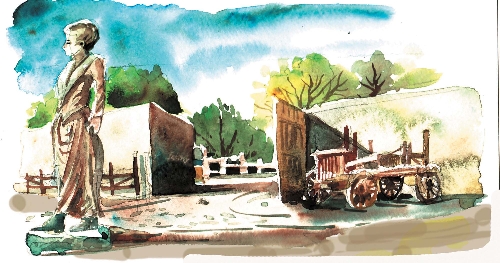Visit Old Mormon Fort to learn Las Vegas history

A handsome life-sized bronze statue of pioneer Las Vegas rancher Helen J. Stewart welcomes visitors to the Old Mormon Fort State Historical Park, where she ranched and raised her family in the late 1800s. The statue stands in the courtyard of the park’s visitor center along the pathway into the restored fort at the corner of Las Vegas Boulevard and Washington Avenue.
Unveiled during dedication ceremonies last month, the sculpture by Benjamin Victor portrays Las Vegas’ “First Lady” as a petite, attractive figure dressed nicely as befitted her position as a community leader but stepping toward the realities of frontier life wearing sturdy work boots. The artist selected for this bronze was well-known for his creation of another stalwart Nevada woman, Sarah Winnemucca. As a young artist, Victor won a contest to sculpt the Nevada Native American, an advocate for her people. The statue of Sarah Winnemucca in native costume stands in the U.S. Capitol Building’s Statuary Hall.
Stop by the Old Mormon Fort for an introduction to Las Vegas history. It’s open all year from 8 a.m. to 4:30 p.m., Tuesdays through Saturdays. The park’s entry is about half a block east of Las Vegas Boulevard on Washington Avenue. Park entrance costs just $1 for visitors older than 12.
Desert landscaping accents the walkway from the parking area to the visitor center, a striking structure designed to capture natural light. Inside, exhibits and historical artifacts explain the significance of the site. Located along a creek with abundant water in the arid desert, the site drew early cultures, explorers, rustlers, travelers, Mormon colonists, miners, ranchers and railroads.
Beyond the new statue in the courtyard, paths invite visitors to explore. Follow one path past the re-creation of Las Vegas Creek, complete with native vegetation and footbridge. Another path leads to the area set aside for a pioneer garden that produces flowers and edibles in season. Walk through a large entrance into the fort’s interior, a quadrangle surrounded by reconstructed walls and bastions at two opposing corners.
A group of 30 Mormon missionaries built the fort in 1855 as part of the first permanent non-native settlement. The colony’s purpose was to create a wayside for overland travelers on the Mormon Road connecting Utah and California colonies, as well as to contact area Paiutes. A remnant of the wall is thought to be the oldest pioneer structure in Nevada.
The Mormon settlement lasted two years, during which time the pioneers built the fort, set up a school, planted orchards, irrigated garden plots and mined for lead at Mount Potosi. After the colony disbanded in 1857, the site lay abandoned for several years, until 1865 when El Dorado Canyon miner Octavius Gass partnered with a relative of one of the missionaries to operate a store and blacksmith shop to serve overland travelers and to raise livestock on the ranch.
Gass took out a loan with Pioche freight company owner Archibald Stewart. When he defaulted on the loan, Stewart acquired the property. He brought his young wife and children to the remote ranch in 1882, promising it would be for just a couple of years. Unfortunately, Stewart’s promise was kept when he was killed two years later by a neighbor in a gunfight at the Kiel Ranch. For lack of available milled lumber in an area so far from civilization, Helen had to use the doors of her house to build a coffin to bury her husband.
Just 30 years old with four young children and another on the way, she proved tough and plucky but always a lady. With her father’s help, she continued to run the ranch. The pair bought up more property when rumors of a coming railroad began to circulate. She eventually bought out her father’s share.
In 1903, she married another man named Stewart (no relation to the first) and sold her ranch to Montana Senator William A. Clark, whose railroad arrived in 1905. Not forgetting her early friends, Stewart provided acreage for the Las Vegas Paiute colony.
As Las Vegas grew following a 1905 land auction, Stewart contributed significantly to the young town. A founder of the first Episcopal church and the Mesquite Club, she served as the first postmistress, first woman juror and first female school board member.
Stewart died in 1926 at age 72.
Margo Bartlett Pesek’s column appears Sundays.












